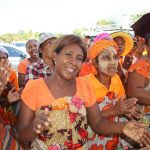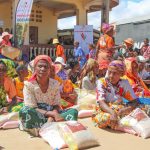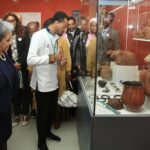Part of the history of North Sakalava of Madagascar.
In 1828, King Antakaragna Tsialana I Mourut. And his son Tsimiaro succeeded him.
For two years, from 1835 to 1837, Tsimiaro struggled against the Hovas of the Fort of Ambohimarigny. Vanquished at first, he took refuge, as Andrianantsirirso had done, in the caves of Ankaragna and there held his opponents. Finally, he escaped to Nosy Mitsio in 1838.
From Nosy-Mitsio, he sent one of his brothers to Zanzibar to conclude an alliance with the Arabs. This displacement was without result. In 1839, Tsimiaro charged an ambassador to go to Mauritius to request the help of the English government. Again, he did not get any satisfactory results.
Looking for an alliance at all costs, King Tsimiaro went in person to the island of the meeting where he concluded an alliance pact with King Louis Philippe I.
As soon as they learned the signing of this alliance, the Sakalavas kings were dissatisfied and reproached violently in Tsimiaro to allow Europeans to land on their territory and seize it.
Lightening himself against him, they summoned him to return the French infantry body, recently landed. King Tsimiaro refused. His opponents attacked him.
The Sakalavas were defeted at Nosy-Faly and the French remained in Nosy-Be.
Tsimiaro was a knight of the Legion of Honor and received from the Government an annual pension of one hundred francs.
In 1882, after fifty three years of reigning, Tsimiaro died and his son, Tsiamentana II, came to power in 1883.
In 1885, the very tense relations between French and Hovas brought the war. Near Vohemar, Tsialanagna II bound by the Treaty that his father had signed in 1840 with the King of France, sent two thousand Antankaragnas commanded by his brother, to lend his hand to the French. Himself, in the meantime, took place in Nosy-Mitsio with three hundred warriors, aboard the ship “Beautempharmeter”.
After defeating, the Hovas in Andrampagna 40 km south of Vohemar, the Antankaragna Vohemar returned home. Tsialanagna II and some notables were summoned to Tamatave where Admiral Miot decorated, in great solemnity, of Madagascar’s commemorative medal.
In 1884, at the beginning of the conquest, the French Commander of Nosy-Bé asked Tsialanagn II to provide him 150 men to reach the French expeditionary for Marovoay.
Satisfaction was given to him immediately.
In the same year, he warned against the Hovas in the government of Ampombantambo.
In May 1895, the Hova army commissioned by Ratovelo Porta! War in the bass plain of Mahavavy.
Vanquished in Campaign, at Betamboho (MasinDrano) The Antankaranas took refuge in Nosy Mitsio, Nosy-Faly and Nosy-Be. The Hovas confiscated their herds, burned villages, forests and destroyed crops.
Only in 1897 when Lieutenant Chénéron designated to administer the Antankaragna sectors, was settled in Ambatoharagna, which Tsialanagna II and his supporters came to join him. There he continued to show great loyalty to France during the pacification of the Northwest region.
In 1899, the chief town of the French sector was transferred first to Ambakirano, then to Ambato became annexed sector of Grande-Terre.
There was fixed the residence of the French Commander with whom came to live Tsialanagna II, Queen Binao and King Sakalava Bemazava Tsiaraso. These three characters were named governors, and Tianjagnahary, Fagnahibe and Behaka, descendants of royal families, deputy governors.
In 1906, when removing the French circle of the Great Earth, the Sakalavas kings each returned to their respective countries. The Antakaragna sector was then transformed into Antakaragna District with Ambato for Chief Taloha and then Ambilobe Taloha.
In 1911, by a decree dated December 12, District Antankaragna became Autonomous Ambilobe District.
King Tsialanagna II died in October 1924 in Ambatoharagna where he was buried according to his will, unlike the old customs who wanted the Antankaragna kings were buried in the caves of Ankaragna.
Tsimanenigny, his younger brother, was at his death, named King of the Antankaragna, in January 1925. He is now 80 years old and saw peace in Ambatoharagna, and desired to rest, after his death, in the caves of the Ankaragna, alongside his ancestors.
- CULTURE PLAYS AN IMPORTANT ROLE IN ECONOMIC DEVELOPMENT - 28 May 2024
- THE PRIDE OF WOLAYTA: THE HEROIC BOXER BETEL WOLDE - 11 April 2024
- THE PEACEFUL CELEBRATION OF EID HOLIDAY IN HARAR CITY - 10 April 2024







